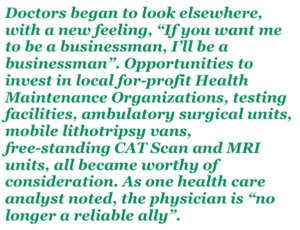The Three Pillars of the Medical-Industrial Complex and the Physician. Part 3. Rapid Cost Escalation.
Posted on | July 6, 2016 | Comments Off on The Three Pillars of the Medical-Industrial Complex and the Physician. Part 3. Rapid Cost Escalation.
Mike Magee
As we have seen, by the time the 1990’s arrived, prospects for the premier academic health systems were looking questionable. The educational enterprise was increasingly underfunded. Inpatient reimbursement continued to decline alongside admissions and length of stay. The massive faculty hirings of the 70’s and 80’s now left the institutions with aging, top heavy faculty, and little room for young, research savvy faculty to advance. Care was increasingly going out-patient, which complicated the training of residents and students. And cost-control, top down administrative pressures, and demands for time commitments to re-engineer patient care processes to increase efficiency and decrease costs were everywhere. Where the large academic centers had become comfortable with a 30% add-on compared to community hospitals, New York Times columnist, Steven Brill, comments that they now felt lucky if they could clear a 15% differential. Part of their solution, a large part, was to pursue more research dollars in earnest.

Doctors everywhere felt under attack. The numbers of physicians kept increasing as patient utilization rates remained in steep decline. Malpractice rates were skyrocketing, exceeding $100,000 a year in some specialties like obstetrics, orthopedics, and neurosurgery. Private practice opportunities were increasingly rare. Managed care restrictions were pervasive and intrusive, and ate into patient care time. Doctors began to look elsewhere, with a new feeling, “If you want me to be a businessman, I’ll be a businessman”. Opportunities to invest in local for-profit Health Maintenance Organizations, testing facilities, ambulatory surgical units, mobile lithotripsy vans, free-standing CAT Scan and MRI units, all became worthy of consideration. As one health care analyst noted, the physician is “no longer a reliable ally”.
The Balanced Budget Act of 1997 reinforced all these trends by incentivizing the rise of Managed Medicare. The appearance of choice further strengthened the belief among employers that the health care benefits they provided their employees should increasingly be positioned as a “defined contribution” rather than a “defined benefit”. The creation of alternate choices for the Medicare population was predicted to save $115 billion over the next five years. The future survival of hospitals now required more choice, less cost, more efficiency, more ambulatory care, more patient empowerment and shared risk, and more prevention. To accomplish these goals, most hospitals focused on geographic dominance, integrated information systems, continuity of care plans, new information technology with shared compatibility among partners, and an emphasis on predicable cost, measured quality, and documented patient satisfaction.
Into the mix were thrown a vast array of non-profit and for-profit hospitals looking at reorganization as their salvation. The 1980’s had witnessed the closing of more than 600 hospitals. This trend continued for the next two decades, and included closure of hospitals from small rural to large city run public facilities. Many hospitals merged or were acquired. And physicians increasingly opted to be employees of these ever growing health systems rather than compete with them as independent professionals. As the community networks strengthened, the pressures on the top flight academic health centers intensified, as they found themselves competing with increasingly sophisticated suburban hospitals staffed with physicians and nurses they had trained.
What were their options now? They ended up largely doubling down on their differentiating strengths: biomedical research, specialty medical training and care, complex high tech interventional medical and surgical procedures, and care for urban, poor, and very sick patients with the hopes that supplemental funding would be provided. To do this, they signed cooperative research agreements with industry, built research buildings and opened clinical research units, staffed up specialized patent offices with intellectual property lawyers, and encouraged faculty to pursue federal grant money. They also widened their formal affiliations with a range of out-patient care organizations and an array of network hospitals, struck deals with pharmaceutical and medical device companies, and pushed their medical staff to be more productive in hospital-sponsored practice plans which would eventually generated more then 50% of their patient care revenue.
Hospital beds nationwide decreased by 200,000 in the ensuing decade, and yet occupancy rates still hovered at 65%. So the shake out of the hospital industry has continued. As reported by Steven Brill, clearly part of the strategy has been to eliminate the middlemen. This included insurers, and is why many large health systems have now formed their own insurance companies and are working directly with employers. Health economist, Zeke Emanuel, who labored on Obamacare, said, “Aetna is Blockbuster”. He believed their time has passed. But United Health Care CEO, Stephen Hemsley, saw just the opposite. He said, “We operate the largest hospital system in Brazil…We have the data analytic skills, the financial resources, and financing and regulatory experience that hospitals going into insurance may not have.”
It was under these circumstances that President Obama entered office in 2008, and made the political assessment that it was now or never for health care reform. He saw waste and excess everywhere he looked. In Part 4, we’ll look at the numbers and the White House team that designed the Affordable Care Act.
Tags: academic health systems > health insurance industry > hospital industry > medical-industrial complex > pharmaceutical industry > physician relations.



